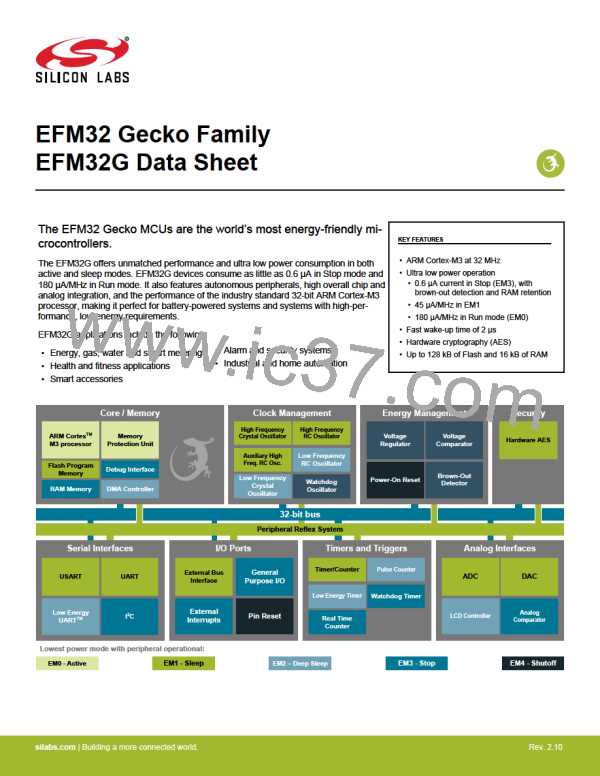EFM32G Data Sheet
System Overview
3.1.4 Direct Memory Access Controller (DMA)
The Direct Memory Access (DMA) controller performs memory operations independently of the CPU. This has the benefit of reducing
the energy consumption and the workload of the CPU, and enables the system to stay in low energy modes when moving for instance
data from the USART to RAM or from the External Bus Interface to a PWM-generating timer. The DMA controller uses the PL230
µDMA controller licensed from ARM.
3.1.5 Reset Management Unit (RMU)
The RMU is responsible for handling the reset functionality of the EFM32G.
3.1.6 Energy Management Unit (EMU)
The Energy Management Unit (EMU) manage all the low energy modes (EM) in EFM32G microcontrollers. Each energy mode man-
ages if the CPU and the various peripherals are available. The EMU can also be used to turn off the power to unused SRAM blocks.
3.1.7 Clock Management Unit (CMU)
The Clock Management Unit (CMU) is responsible for controlling the oscillators and clocks on-board the EFM32G. The CMU provides
the capability to turn on and off the clock on an individual basis to all peripheral modules in addition to enable/disable and configure the
available oscillators. The high degree of flexibility enables software to minimize energy consumption in any specific application by not
wasting power on peripherals and oscillators that are inactive.
3.1.8 Watchdog (WDOG)
The purpose of the watchdog timer is to generate a reset in case of a system failure, to increase application reliability. The failure may
e.g. be caused by an external event, such as an ESD pulse, or by a software failure.
3.1.9 Peripheral Reflex System (PRS)
The Peripheral Reflex System (PRS) system is a network which lets the different peripheral module communicate directly with each
other without involving the CPU. Peripheral modules which send out Reflex signals are called producers. The PRS routes these reflex
signals to consumer peripherals which apply actions depending on the data received. The format for the Reflex signals is not given, but
edge triggers and other functionality can be applied by the PRS.
3.1.10 External Bus Interface (EBI)
The External Bus Interface provides access to external parallel interface devices such as SRAM, FLASH, ADCs and LCDs. The inter-
face is memory mapped into the address bus of the Cortex-M3. This enables seamless access from software without manually manipu-
lating the IO settings each time a read or write is performed. The data and address lines are multiplexed in order to reduce the number
of pins required to interface the external devices. The timing is adjustable to meet specifications of the external devices. The interface is
limited to asynchronous devices.
3.1.11 Inter-Integrated Circuit Interface (I2C)
The I2C module provides an interface between the MCU and a serial I2C-bus. It is capable of acting as both a master and a slave, and
supports multi-master buses. Both standard-mode, fast-mode and fastmode plus speeds are supported, allowing transmission rates all
the way from 10 kbit/s up to 1 Mbit/s. Slave arbitration and timeouts are also provided to allow implementation of an SMBus compliant
system. The interface provided to software by the I2C module, allows both fine-grained control of the transmission process and close to
automatic transfers. Automatic recognition of slave addresses is provided in all energy modes.
3.1.12 Universal Synchronous/Asynchronous Receiver/Transmitter (USART)
The Universal Synchronous Asynchronous serial Receiver and Transmitter (USART) is a very flexible serial I/O module. It supports full
duplex asynchronous UART communication as well as RS-485, SPI, MicroWire and 3-wire. It can also interface with ISO7816 Smart-
Cards, and IrDA devices.
3.1.13 Pre-Programmed USB/UART Bootloader
The bootloader presented in application note AN0003 is pre-programmed in the device at factory. Autobaud and destructive write are
supported. The autobaud feature, interface and commands are described further in the application note.
silabs.com | Building a more connected world.
Rev. 2.10 | 11
